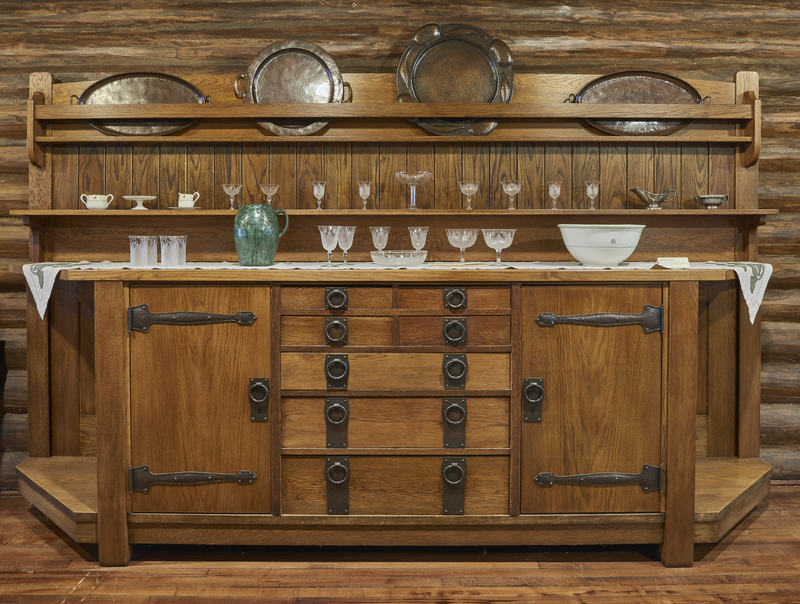Sideboard
Item
Title
Sideboard
Creator
Craftsman Workshops
Date
1911 (ca.)
Dimensions
70 ¾ x 120 ½ x 24 ¼ inches
Medium
Oak, leather, and cedar with copper hardware. Beech, poplar, and laminate (secondary woods).
Object No.
1997.1.a,b
Credit line
Anonymous Gift
Marks
Multiple pencil inscriptions, on drawers (top to bottom, left to right):
Drawer 1: on back “2 ¼ x ⅝ x 2(?)” in script: “Side board G.S.”/ “2” on underside.
Drawer 2: on back “3” in script: “Side board G.S.”/ “3” on underside.
Drawer 3: on back “2 x 3 ¼ 5” in script: “Side board G.S." / “5” on underside.
Drawer 4: on back “4” / “4” on underside.
Drawer 5: no markings located.
Drawer 6: on back “7 - 6 ¼ x ⅝” in script: “Side board G.S.”
Drawer 7: on back “1 7 ¼ x ⅝” in script: “Side board G.S.”
“G.S. Side board” in large script on underside of dust board between drawers 6 and 7.
On cabinet rail facing drawer sides the Roman numerals “I,II,III,IIII” are struck vertically. These do not correspond to the drawer numbering scheme indicated in pencil.
Drawer 1: on back “2 ¼ x ⅝ x 2(?)” in script: “Side board G.S.”/ “2” on underside.
Drawer 2: on back “3” in script: “Side board G.S.”/ “3” on underside.
Drawer 3: on back “2 x 3 ¼ 5” in script: “Side board G.S." / “5” on underside.
Drawer 4: on back “4” / “4” on underside.
Drawer 5: no markings located.
Drawer 6: on back “7 - 6 ¼ x ⅝” in script: “Side board G.S.”
Drawer 7: on back “1 7 ¼ x ⅝” in script: “Side board G.S.”
“G.S. Side board” in large script on underside of dust board between drawers 6 and 7.
On cabinet rail facing drawer sides the Roman numerals “I,II,III,IIII” are struck vertically. These do not correspond to the drawer numbering scheme indicated in pencil.
Description
Anchoring the large wall of the dining room in the log house, this large sideboard was custom built for Stickley by his cabinetmakers, probably in 1911. Like the sideboard built for his home in Syracuse, the proportions are massive and—like the five known examples of this form—it features canted corners, two large storage cabinets, and central drawers graduated in size. Unlike the earlier iterations of this form, Stickley chose delicate copper hardware for this example, eschewing the heaviness of a wrought iron set. The addition of a plate rack, as well as the facing boards underneath the corners, distinguishes this sideboard from other extant examples.
Unlike his early productions in which quarter-sawn oak was employed almost exclusively, the rising costs of materials throughout the first decade of the twentieth century forced Stickley to employ lower-cost secondary woods on the interiors of his furniture. Even in this sideboard, which was custom made for the dining room of the log house, Stickley employed poplar for some of the framing members and beech for the drawer backs and sides. A laminate was employed for the drawer bottoms, though these are lined either in soft leather (designed for holding flatware) or cedar (for storing textiles) and would not be evident to users.
Unlike his early productions in which quarter-sawn oak was employed almost exclusively, the rising costs of materials throughout the first decade of the twentieth century forced Stickley to employ lower-cost secondary woods on the interiors of his furniture. Even in this sideboard, which was custom made for the dining room of the log house, Stickley employed poplar for some of the framing members and beech for the drawer backs and sides. A laminate was employed for the drawer bottoms, though these are lined either in soft leather (designed for holding flatware) or cedar (for storing textiles) and would not be evident to users.
Provenance
Gustav Stickley (by 1911); sold with the contents of Craftsman Farms in 1917 to George and Sylvia Farny; by descent to Cyril Farny; purchased by an anonymous donor on behalf of the Craftsman Farms Foundation.

